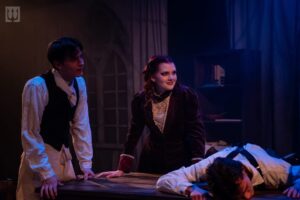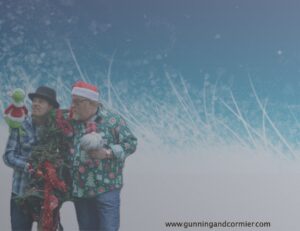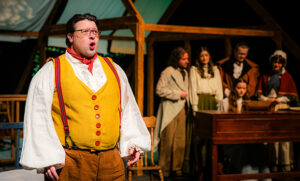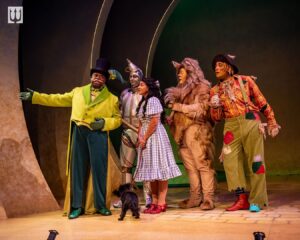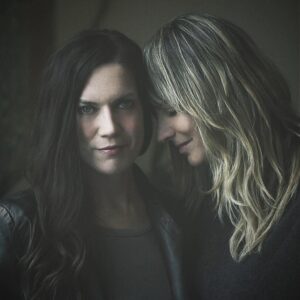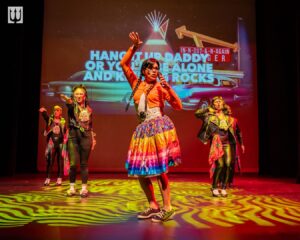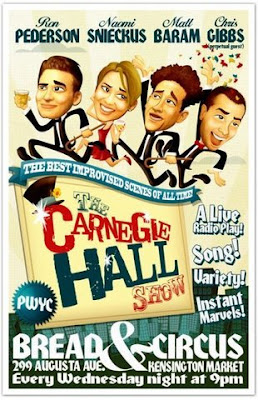 I have these hazy memories of flipping through the stations on television when I was around nine or ten years old and happening upon these shows on PBS in the wee hours of the night, in black and white, where old men in tuxedos, who were not famous, would pontificate on inane trivia referring to video footage of people who were famous, like Frank Sinatra, and Ella Fitzgerald, Dean Martin and Judy Garland. It was perhaps the precursor to Pop Up Video. Nevertheless, these hazy memories come to the forefront of my brain every time I catch The National Theatre of the World’s The Carnegie Hall Show. Here, the New Bread and Circus Theatre is transformed into that Cathedral of Drama, Carnegie Hall, and Matt Baram, Ron Pederson and Chris Gibbs don tuxedos, and Naomi Snieckus wears a lovely black dress, and they pontificate on inane trivia referring to imaginary video footage as they improvise a retrospective of the “Greatest Improvised Scenes Ever Written.”
I have these hazy memories of flipping through the stations on television when I was around nine or ten years old and happening upon these shows on PBS in the wee hours of the night, in black and white, where old men in tuxedos, who were not famous, would pontificate on inane trivia referring to video footage of people who were famous, like Frank Sinatra, and Ella Fitzgerald, Dean Martin and Judy Garland. It was perhaps the precursor to Pop Up Video. Nevertheless, these hazy memories come to the forefront of my brain every time I catch The National Theatre of the World’s The Carnegie Hall Show. Here, the New Bread and Circus Theatre is transformed into that Cathedral of Drama, Carnegie Hall, and Matt Baram, Ron Pederson and Chris Gibbs don tuxedos, and Naomi Snieckus wears a lovely black dress, and they pontificate on inane trivia referring to imaginary video footage as they improvise a retrospective of the “Greatest Improvised Scenes Ever Written.”The fun, of course, stems from the fact that Improv scenes are not “written” and to rehearse or rehash that which was once improvised is no longer Improv and so everything you see is a spontaneous marvel. The way The National Theatre of the World plays with the form of improvisation is appreciated richly by those who have an understanding of the form and the theory of the art. Improvisers, comedians and actors relish in the cleverness of having the wheels show, and the Pirandello-esque commentary on the action from within.
The Carnegie Hall Show is a grand celebration of play. Baram, Pederson, Gibbs and Snieckus relish in the opportunity to make things up. To make things poetical for no particular reason, to make things complicated to revel in the joy of becoming tied up in words and muddled in their own imaginations, to make things absurd, and to challenge each other to rise toward infinite possibilities and to perform beyond the boundaries.
The Carnegie Hall Show pays homage to a charming, nostalgic black and white time, and yet also craftily exposes its allusions to the misogynistic, racist and homophobic ideologies prevalent at that time. Nothing is sacred here. The mundane and humdrum are celebrated as in the style of Carnival, while all that is weighty becomes the essence of the play. The charm is that although the show may seem grand and pretentious, it actually follows very few rules. The history of the theatre, and indeed, the history of the world, is made up before your eyes and recited to you with every solemnity of truth. “1933: that was the year comedy was invented.” “Improvised scenes were sometimes written. That’s how they improvise on television.” “That was when there was a Prohibition of Improvathons.” “There were no such things as Jokes until 1900.” There is slapstick for the sake of slapstick and pratfalls for the sake of pratfalls. The joy comes from allowing yourself to indulge in the skill and the mastery of it, and the joy you can see in the performers stems from being able to indulge themselves as they create their own reality before your very eyes. Yet, they are subverting this indulgence because they are continually so aware of what they are doing. If Brecht taught a class in Improv, this is exactly what his students would do.
The Carnegie Hall Show also boasts of a Live Improvised Radio Drama, which, may be one of the most difficult things a bunch of actors can attempt to do onstage, a special musical guest (accompanied by the great Jeff Raimondo at the piano, who provides dramatic music throughout the show), special guest stars (tonight was the crazy clown duo Miller and Mullet), and a gosh-darn sing-along, which I think is always a rousing rendition of “It’s A Wonderful World.” This does sort of make you feel as though you’ve slipped beyond the rainbow and instead of Technicolor Oz, you’ve found yourself in a black and white world of a distant time.
If you, like me, ever wished you could permeate into your television in the middle of a Film Noir Detective episode of a vintage cartoon show, or transport yourself to Mindy’s for some cheesecake with Brando and Sinatra, The Carnegie Hall Show may be just the trip to take, just make sure to heed those banana peels and mind the spittake; it’s compulsory.
The National Theatre of the World presents The Carnegie Hall Show every Wednesday at sometime between 9:00pm-9:30pm at the Bread and Circus Theatre. 299 Augusta Avenue in Kensington Market. Pay What You Can.

